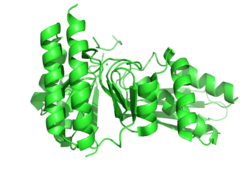Biology:Mevalonate kinase
| Mevalonate Kinase | |||||||||
|---|---|---|---|---|---|---|---|---|---|
 | |||||||||
| Identifiers | |||||||||
| EC number | 2.7.1.36 | ||||||||
| CAS number | 9026-52-2 | ||||||||
| Databases | |||||||||
| IntEnz | IntEnz view | ||||||||
| BRENDA | BRENDA entry | ||||||||
| ExPASy | NiceZyme view | ||||||||
| KEGG | KEGG entry | ||||||||
| MetaCyc | metabolic pathway | ||||||||
| PRIAM | profile | ||||||||
| PDB structures | RCSB PDB PDBe PDBsum | ||||||||
| Gene Ontology | AmiGO / QuickGO | ||||||||
| |||||||||
 Generic protein structure example |
Mevalonate kinase is an enzyme (specifically a kinase) that in humans is encoded by the MVK gene.[2][3] Mevalonate kinases are found in a wide variety of organisms from bacteria to mammals. This enzyme catalyzes the following reaction:
.
Function
Mevalonate is a key intermediate, and mevalonate kinase a key early enzyme, in isoprenoid and sterol synthesis.[2] As the second enzyme in the Mevalonate pathway, it catalyzes the phosphorylation of Mevalonic acid to produce Mevalonate-5-phosphate.[4] A reduction in mevalonate kinase activity to around 5-10% of its typical value is associated with the mevalonate kinase deficiency (MVD) resulting in accumulation of intermediate mevalonic acid.[5]
Clinical significance
Defects can be associated with hyperimmunoglobulinemia D with recurrent fever.[6]
Mevalonate kinase deficiency caused by mutation of this gene results in mevalonic aciduria, a disease characterized psychomotor retardation, failure to thrive, hepatosplenomegaly, anemia and recurrent febrile crises. Defects in this gene also cause hyperimmunoglobulinaemia D and periodic fever syndrome, a disorder characterized by recurrent episodes of fever associated with lymphadenopathy, arthralgia, gastrointestinal dismay and skin rash.[2] The symptoms of the disease typically start at infancy and may be additionally triggered by stress or bacterial infection. Children with mevalonate kinase deficiency may remain undiagnosed for a long time as there is not enough scientific data at the moment to accurately diagnose children with the disease.[5]
See also
- Mevalonic aciduria
- Mevalonic acid
References
- ↑ PDB: 2X7I; "The Scottish Structural Proteomics Facility: targets, methods and outputs". Journal of Structural and Functional Genomics 11 (2): 167–80. June 2010. doi:10.1007/s10969-010-9090-y. PMID 20419351.
- ↑ 2.0 2.1 2.2 "Entrez Gene: mevalonate kinase". https://www.ncbi.nlm.nih.gov/sites/entrez?Db=gene&Cmd=ShowDetailView&TermToSearch=4598.
- ↑ "Molecular cloning of human mevalonate kinase and identification of a missense mutation in the genetic disease mevalonic aciduria". The Journal of Biological Chemistry 267 (19): 13229–38. July 1992. doi:10.1016/S0021-9258(18)42199-0. PMID 1377680.
- ↑ "Hyper-IgD syndrome/mevalonate kinase deficiency: what is new?". Seminars in Immunopathology 37 (4): 371–6. July 2015. doi:10.1007/s00281-015-0492-6. PMID 25990874.
- ↑ 5.0 5.1 "Mevalonate kinase genotype in children with recurrent fevers and high serum IgD level". Rheumatology International 33 (12): 3039–42. December 2013. doi:10.1007/s00296-012-2577-z. PMID 23239036.
- ↑ Online Mendelian Inheritance in Man (OMIM) 260920
Further reading
- "Identifying leukocyte gene expression patterns associated with plasma lipid levels in human subjects". Atherosclerosis 191 (1): 63–72. March 2007. doi:10.1016/j.atherosclerosis.2006.05.032. PMID 16806233.
- "Newly identified loci that influence lipid concentrations and risk of coronary artery disease". Nature Genetics 40 (2): 161–9. February 2008. doi:10.1038/ng.76. PMID 18193043.
- "Hyper-IgD syndrome with novel mutation in a Japanese girl". Modern Rheumatology 19 (1): 96–9. 2009. doi:10.1007/s10165-008-0130-4. PMID 18941711.
- "The role of peroxisomes in cholesterol metabolism". American Journal of Respiratory Cell and Molecular Biology 7 (4): 358–64. October 1992. doi:10.1165/ajrcmb/7.4.358. PMID 1356376.
- "Biochemical and genetic aspects of mevalonate kinase and its deficiency". Biochimica et Biophysica Acta (BBA) - Molecular and Cell Biology of Lipids 1529 (1–3): 19–32. December 2000. doi:10.1016/s1388-1981(00)00135-9. PMID 11111075. https://pure.uva.nl/ws/files/3751864/23070_Thesis.pdf.
- "Biochemical and structural basis for feedback inhibition of mevalonate kinase and isoprenoid metabolism". Biochemistry 47 (12): 3715–24. March 2008. doi:10.1021/bi7024386. PMID 18302342.
- "Common variants at 30 loci contribute to polygenic dyslipidemia". Nature Genetics 41 (1): 56–65. January 2009. doi:10.1038/ng.291. PMID 19060906.
- "Mevalonate kinase deficiency and autoinflammation". The New England Journal of Medicine 357 (18): 1871–2. November 2007. doi:10.1056/NEJMc072799. PMID 17978300.
- "No interaction between alcohol consumption and HDL-related genes on HDL cholesterol levels". Atherosclerosis 211 (2): 551–7. August 2010. doi:10.1016/j.atherosclerosis.2010.04.001. PMID 20430392.
- "Multiple genetic variants along candidate pathways influence plasma high-density lipoprotein cholesterol concentrations". Journal of Lipid Research 49 (12): 2582–9. December 2008. doi:10.1194/jlr.M800232-JLR200. PMID 18660489.
- "A novel missense mutation in MVK associated with MK deficiency and dyserythropoietic anemia". Pediatrics 125 (4): e964-8. April 2010. doi:10.1542/peds.2009-1774. PMID 20194276.
- "Large scale replication analysis of loci associated with lipid concentrations in a Japanese population". Journal of Medical Genetics 46 (6): 370–4. June 2009. doi:10.1136/jmg.2008.064063. PMID 19487539.
- "Autoinflammatory gene mutations in Behçet's disease". Annals of the Rheumatic Diseases 66 (6): 832–4. June 2007. doi:10.1136/ard.2006.068841. PMID 17213252.
- "Investigation of variants identified in caucasian genome-wide association studies for plasma high-density lipoprotein cholesterol and triglycerides levels in Mexican dyslipidemic study samples". Circulation: Cardiovascular Genetics 3 (1): 31–8. February 2010. doi:10.1161/CIRCGENETICS.109.908004. PMID 20160193.
- "Approach to genetic analysis in the diagnosis of hereditary autoinflammatory syndromes". Rheumatology 45 (3): 269–73. March 2006. doi:10.1093/rheumatology/kei138. PMID 16234278.
- "A diagnostic score for molecular analysis of hereditary autoinflammatory syndromes with periodic fever in children". Arthritis and Rheumatism 58 (6): 1823–32. June 2008. doi:10.1002/art.23474. PMID 18512793.
- "Allelic expression imbalance at high-density lipoprotein cholesterol locus MMAB-MVK". Human Molecular Genetics 19 (10): 1921–9. May 2010. doi:10.1093/hmg/ddq067. PMID 20159775.
- "Regulation of luteinizing hormone receptor mRNA expression by mevalonate kinase--role of the catalytic center in mRNA recognition". The FEBS Journal 275 (13): 3397–407. July 2008. doi:10.1111/j.1742-4658.2008.06490.x. PMID 18494797. https://deepblue.lib.umich.edu/bitstream/2027.42/72773/1/j.1742-4658.2008.06490.x.pdf.
- "Genetic differences between the determinants of lipid profile phenotypes in African and European Americans: the Jackson Heart Study". PLOS Genetics 5 (1): e1000342. January 2009. doi:10.1371/journal.pgen.1000342. PMID 19148283.
- "Novel variants at KCTD10, MVK, and MMAB genes interact with dietary carbohydrates to modulate HDL-cholesterol concentrations in the Genetics of Lipid Lowering Drugs and Diet Network Study". The American Journal of Clinical Nutrition 90 (3): 686–94. September 2009. doi:10.3945/ajcn.2009.27738. PMID 19605566.
External links
- mevalonate+kinase at the US National Library of Medicine Medical Subject Headings (MeSH)
- PDBe-KB provides an overview of all the structure information available in the PDB for Human Mevalonate kinase
 |



